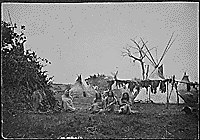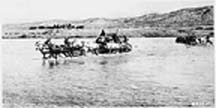Background Event: Congress signed an appropriations bill declaring no further Indian treaties were to be signed with Indian nations or tribes. Indians were to be treated as individuals. Since they were not citizens of the U.S., they had no legal rights. July: Company in the Field. September 19,1871, Company at Ft. Sill Indian Territory: A detachment of Troop B was attacked by a large war party. One soldier and a horse were killed. Two Indians were killed with three wounded. October 1871: Red River; Troop B is ambushed by Kiowa as they scouted along the Red River. Trooper Larkin Foster was killed. The attackers escaped. November, 1871-February, 1872 Company at Ft. Sill, I.T.: Raids and other assorted deprivations diminished in the winter cold. With the arrival of spring, Chief White Horse, and Big Bow of the Kiowa, who were not partial to peace, joined the Comanches. Later that year, prominent Indian chiefs visited Washington, but again they refused to surrender to the government's demands. April 1872, Company in the field: Colonel Grierson is ordered to St. Louis as Superintendent of the Mounted Recruiting Service. Lieutenant Colonel Davidson took command of the regiment. He fired all of Grierson's old staff, but superiors, saying the appointments was temporary reversed his orders. May 1872: Company at Fort Sill. Background Event: John H. Conyers becomes the first African-American to enter the United States Naval Academy. June7th: Company left Fort Sill and marched 229 miles arriving at Deer Creek, I.T. on June 10th. June 12, 1872: Troops A and L attacked by a war party on Deep River I.T. Casualties not reported. Background Event:
The tanning industry created a new process for tanning hides, which caused a tremendous
demand for buffalo hides. General Sherman actively encourages the slaughter of the buffalo. He recognizes the cultural
and economic destruction this would have on the
Indian nations. By 1890, 30,000,000 buffalo had been destroyed leaving less than 1,000 on the plains. Rath & Wright's buffalo hide yard in 1878, showing 40,000
July-September, 1872, Camp Supply, I. T.: Relative calm existed on the plains, especially on the reservations. The Five Civilized Nations were having their annual mid-summer conference at Okmulgee. They tried to persuade the plains Indians to give up their resistance to the white man. The leaders of the Five Civilized Tribes were rebuffed, and derided for their own surrender to the white man and the adoption of his ways. July, 1872 -March, 1873: Company at Camp Supply, I.T. November 1872: Mackenzie and the Fourth Cavalry struck the Kwahadi Indians of the Stake Plains. More than 100 women, and children were held hostage to ensure the good behavior of the chiefs during the early months of 1873. Background Event: General Crook
starts his winter campaign.
January, 1873, Camp Supply: Captain Pratt and twenty troopers traveled in below zero weather to bust up ranches whose purpose was to sell liquor, guns, and ammo to the Indians, for whatever they had to trade, including stolen property such as horses, cattle and settlers personal property. They arrested the criminals and seized large quantities of rot-gut-whisky, guns, ammo, clothing and foodstuffs. Thirteen of the Buffalo Soldiers had severe frostbitten hands and feet. After a month in jail and a $10.00 fine, the desperados were back in business. March, 1873, Fort Gibson: Indian Agent Lawrie Tatum, resigned his post, because he disagreed with the release of chiefs Satanta and chief Lone Wolf. He is replaced by James Haworth, who promptly dismissed the detachment of troopers guarding the Indian Agency, believing they were not needed. April, 1873: Company in the Field enroute to Fort Griffin, Texas (change of station). The company left Camp Supply on April 16, 1873. April 30, Company enroute to Fort Griffin, Texas: Troops G and M attack Mexican horse thieves, capturing 36 men plus mules previously stolen. One bandit and a horse were wounded. May 1873-July, 1874; Company at Ft. Griffin, Texas
having arrived there on May 12, 1873.
May, 1873, Reservation, Texas: The Sun Dance is the most important religious ceremony of the year for the plains Indians. With the Kiowa present, Medicine man and prophet, Isatai, says only war can bring back the Buffalo. Lone Wolf, Satanta, and the other chiefs chose Quanah Parker to lead their war parties. August, 1873: Pease River: Troops E and I are attacked.
One warrior is wounded. February 5, 1874, Double Mountain Fork of Brazos River,Texas: Captain Keyes and Troops D and G of the Tenth, in severe weather and after marching nine days, engage a war party. Eleven Indians were killed and sixty-five head of cattle were captured. The warrior's camp was destroyed. April, 1874; Lancaster River, Texas: While in camp, the Tenth U.S. Cavalry Troop A was surprised by Indians. Private William Hutton was wounded. Background Event: The Indians began to habitually take pot shots at troops as they passed the stockade along the Red River. Colonel Davidson asked for and received permission to apprehend the snipers into their perspective reservations without the Indian Agent's approval. May 2, 1874 Big Wichita, Texas: Troop k attacked a band of warriors causing them to leave their stolen horses. Legendary Chiricahua, Chief Cochise August 19, 1874: Company at Fort Sill, I.T. having left Fort Griffin on the 14th (distance marched 150 miles). August 22-23, 1874; Wichita Agency, Indian Territory: Troops
C, E, H, and L fought roughly 400 Comanches and Kiowa. They attempted to burn out the Agency and its friendly Indians.
Four soldiers were lost and four horses. Sixteen warriors were also lost and wounded. Panoramic view Cheyenne Indian Encampment ca. 1883-1888. courtesy National Archives. Very large file October 29, 1874 : Private Alfred Pinkston, Troop M, in personal combat, killed a Kiowa Indian warrior. December 7th : Troop D on Kingfisher Creek, Texas captured thirteen warriors and women of the Southern Cheyenne Tribe. December 28, 1874: Troops D and M captured fifty-two warriors and their ponies after an eight mile chase to the North Fork of the Canadian River. February 17, 1875: Company in the Field having marched to Cheyenne Agency, I. T. to reinforce the garrison. Distance marched 75 miles. Arrived at the Cheyenne Agency on March 1, 1875. Background Event: By
this time, The Red River War of 1874-1875 was considered over.
April, 6, 1875: Cheyenne Agency, Indian Territory:
Lieutenant Keyes and Troops D and M are selected to escort key leaders of the warriors to the seacoast for confinement.
Black Horse of the Cheyennes, while being shackled, escaped from his guard and ran toward his band of people. The
bands of Indians, enraged by stray bullets, decided to engage the troopers in deadly
combat. They unearthed previously hidden weapons and began fighting. After many hours of fighting with the troopers
pinned down for lack of cover, two attempts to charge the hostiles were made. The first attempt was by Troop M
with Captain Rafferty and the other by all of the troops present. The Indians successfully repulsed each advance,
even though a Gatling gun was employed during the second assault. At nightfall, the Indians were able to flee.Troops
D and M, after a 400 mile chase, failed to overtake the warriors. Twenty-one days later, Lieutenant Austin, Sixth
Cavalry from Fort Wallace caught up with the Cheyenne at the North Fork of Sappa Creel in Kansas. Nineteen of the
band decided to fight. They were all killed. One trooper was killed and sixteen wounded of Troop D and three wounded
and one killed in Troop M. Charges of a lack of support were leveled at Captain Keyes and Captain Norvell of Troop
D, by Captain Rafferty, Sixth Cavalry of Troop M. After an investigation, all charges and counter charges were
dismissed. June, 1875, Fort Sill, Indian Territory: Chief Quanah Parker, of the Kwahadi Comanche, leads his people off the Staked Plains to surrender at Fort Sill. June1875-October,1876 Company at Fort Concho: On October 27, 1876 the Company left Fort Concho and proceeded to Fort Clark. July, 1875: Troops A and C captured two Indian villages while on the Staked Plans of Texas. July 14, 1875, Shafter's Expedition: Lieutenant Colonel William Shafter led a four month long expedition into the Staked Plains marking the first time it had been thoroughly explored. He was also ordered to sweep the remaining Indians off the Staked Plains. The expedition consisted of six companies of the Tenth, two of the Twenty-fourth Infantry, one company of the Twenty-Fifth Infantry and Seminole-Negro Indian Scouts with Tonkawa scouts. Supplies were carried by sixty-five wagons and seven hundred mules. A herd of cattle provided meat. September 13, 1875: Indians attacked Troop G of the 10th Cavalry on the Fresh Fork of the Brazos River, Texas. No casualties reported. October 5, 1875: Troops A, F, G, H, and K of the 10th fought Indians, wounding one hostile and capturing his pony.
Send e-mail to: sldavis@buffalosoldier.net
|





